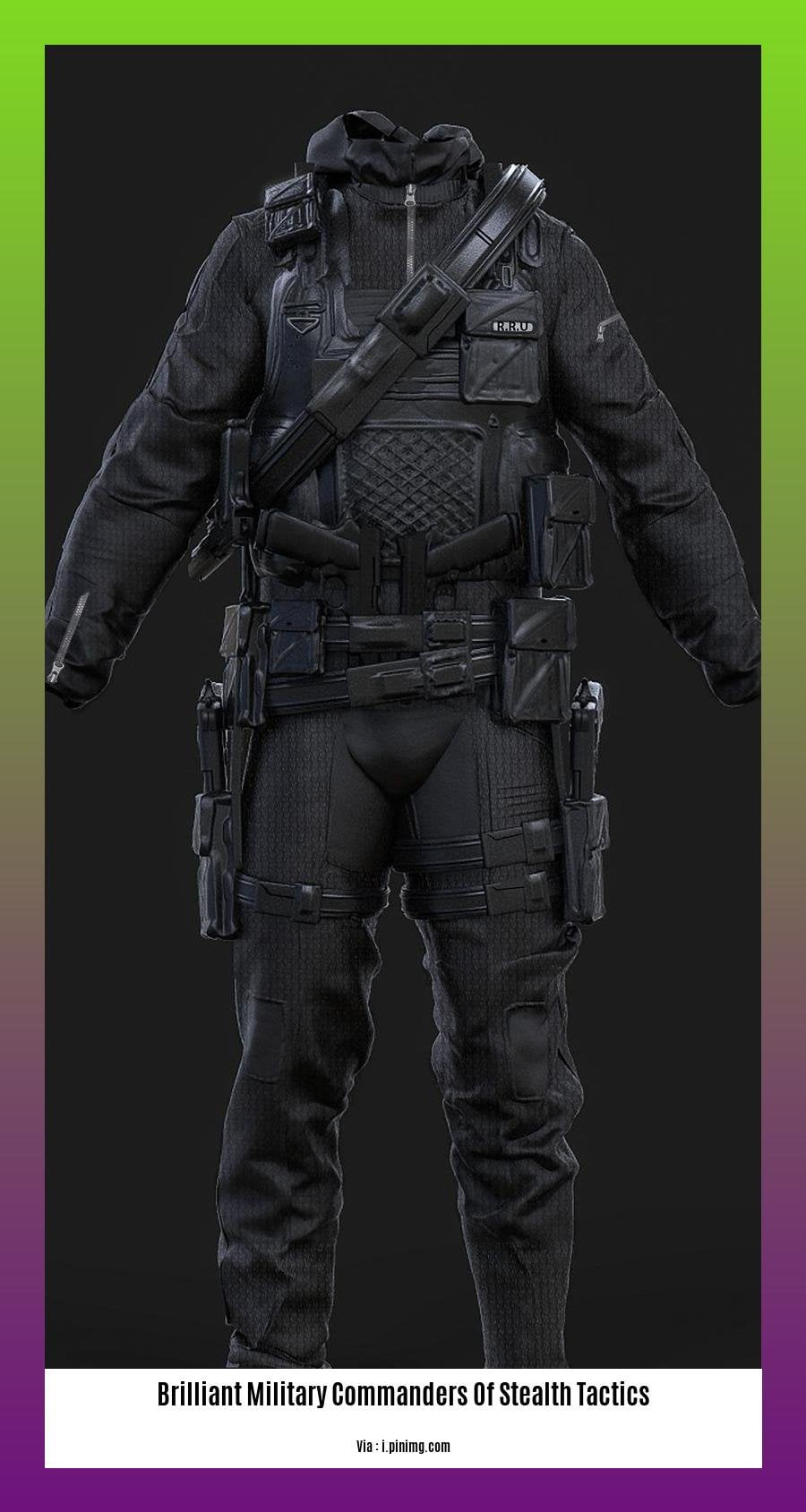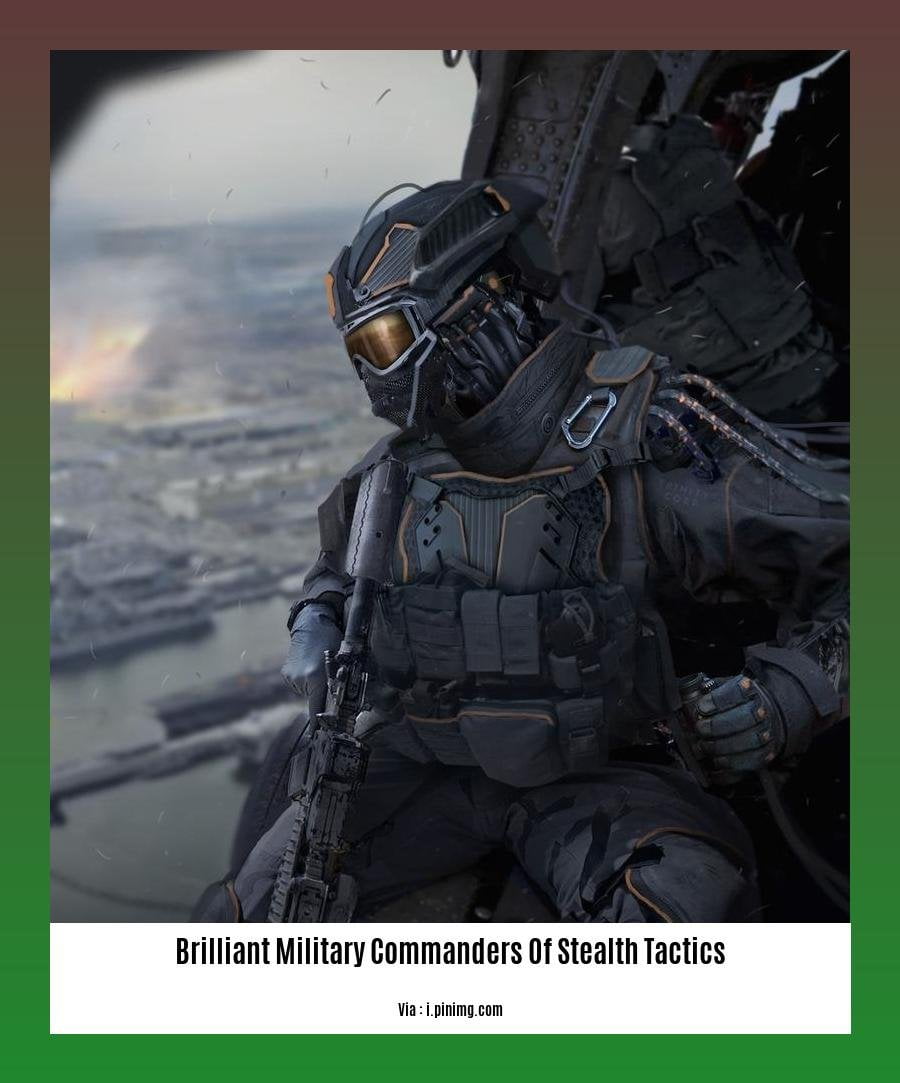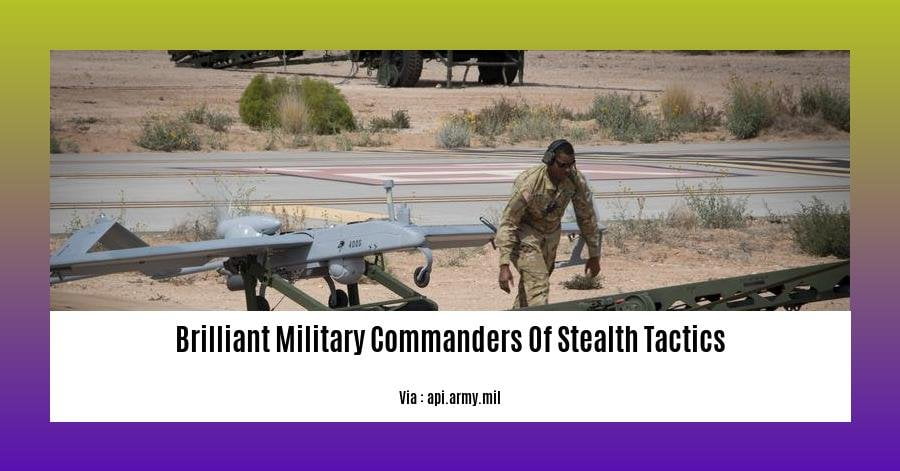Prepare to delve into the captivating world of stealth warfare as we unveil the remarkable stories of [Brilliant Military Commanders of Stealth Tactics: A Historical Exploration]. These exceptional leaders have mastered the art of deception, secrecy, and precision, orchestrating victories that forever altered the course of military history.

Key Takeaways:
- Military commanders like Hannibal Barca, Napoleon Bonaparte, and Alexander the Great excelled in using stealth tactics.
- Sun Tzu’s “The Art of War” emphasized the importance of deception and strategic thinking in stealth warfare.
- Erwin Rommel’s Afrika Korps employed camouflage, mobility, and surprise attacks.
- Julius Caesar’s use of intelligence and speed allowed him to outmaneuver his opponents.
- Genghis Khan’s vast network of spies and swift cavalry tactics gave him an advantage.
- Dwight D. Eisenhower’s planning and coordination of large-scale stealth operations led to the successful Allied landings in Normandy.
Brilliant Military Commanders of Stealth Tactics
Stealth tactics have always played a significant role in wars, allowing armies to gain an advantage by operating undetected. Throughout history, there have been many brilliant military commanders of stealth tactics who have led their troops to victory.
Sun Tzu
Sun Tzu, the Chinese military strategist, is considered one of the greatest practitioners of stealth warfare. His famous work, “The Art of War,” emphasizes the importance of surprise, deception, and mobility in achieving victory.
Scipio Africanus
The Roman general Scipio Africanus is renowned for his daring and innovative tactics. At the Battle of Zama, he employed stealth to ambush the Carthaginian army, leading to a decisive Roman victory and the end of the Second Punic War.
Hannibal Barca
Hannibal, the Carthaginian general, was a master of ambush and deception. His famous crossing of the Alps with his elephants to invade Italy demonstrates his unparalleled skill in stealth tactics.
Genghis Khan
Genghis Khan, the founder of the Mongol Empire, used stealth and deception to conquer vast territories. His lightning-fast raids and relentless pursuit of his enemies made him a formidable opponent.
Frederick the Great
Frederick the Great, the Prussian king, was a pioneer in using stealth and maneuverability to achieve military superiority. He employed night attacks, feints, and surprise tactics to defeat his enemies.
T.E. Lawrence
T.E. Lawrence, better known as Lawrence of Arabia, was a British officer who played a key role in the Arab Revolt against the Ottoman Empire. He used stealth and guerrilla tactics to lead a successful campaign against a technologically superior enemy.
Ulysses S. Grant
Ulysses S. Grant, the American general during the Civil War, was adept at using stealth to outmaneuver his opponents. At the Battle of Vicksburg, he famously employed a flanking maneuver, ultimately leading to the surrender of the Confederate city.
William Tecumseh Sherman
William Tecumseh Sherman, another American general during the Civil War, was known for his use of stealth and subterfuge to win battles. He used scorched-earth tactics and feigned retreats to deceive and weaken his enemies.
These brilliant military commanders have demonstrated the effectiveness of stealth tactics in achieving victory in warfare. Their ingenuity and cunning have inspired generations of soldiers and strategists to seek an advantage over their adversaries through the element of surprise and deception.
Learn about the military commanders adept at tactical deception and their extraordinary strategies. Dive into the fascinating world of masters of the military ambush and cunning, uncovering their ingenious tactics. Explore the captivating stories of deception experts on the battlefield and their unparalleled skills in outwitting their opponents.
Hannibal Barca: Crossing the Alps and Deception
Throughout history, Hannibal Barca’s daring feat of crossing the treacherous Alps with an army and elephants in 218 BC stands as a testament to his brilliance in stealth tactics. Here’s how he pulled off this audacious maneuver:
Negotiated with Local Tribes: To secure safe passage, Hannibal employed diplomacy and subterfuge. He paid bribes and negotiated with local tribes, leveraging his persuasive skills to minimize resistance.
Crossed in Winter: Hannibal intentionally chose winter to cross the Alps, when the passes were less guarded. The harsh conditions and treacherous terrain worked to his advantage, as the Romans least expected an attack during this time.
Used Deception to Conceal His Plans: Hannibal kept his ultimate destination secret, misleading his opponents about his intentions. This deception allowed him to move swiftly and catch the Romans off guard.
Key Takeaways:
- Stealth tactics involve operating undetected and gaining an advantage through surprise and deception.
- Commanders must be adaptable and willing to take risks to execute stealthy maneuvers successfully.
- Diplomacy and negotiation can be valuable tools in stealth warfare, reducing opposition and facilitating safe passage.
Relevant URL Source:
- Hannibal’s Secret Weapon
Genghis Khan: Stealth and Lightning-Fast Raids
The Mongol Empire, founded by Genghis Khan, was a formidable force that conquered vast territories in the 13th century. His military prowess was unmatched, and his use of stealth and lightning-fast raids played a crucial role in his success.
Key Takeaways:
Stealth and Surprise: Genghis Khan’s raiders moved swiftly and silently, often striking at night or when the enemy least expected it. This element of surprise often gave them a significant advantage.
Mobility and Speed: The Mongols were highly mobile, thanks to their skilled horsemen and the speed of their horses. They could cover long distances quickly, enabling them to launch surprise attacks and outmaneuver their opponents.
Discipline and Cohesion: Genghis Khan’s army was highly disciplined and organized. They adhered to strict codes of conduct and were able to execute complex maneuvers with precision, allowing them to overwhelm their foes.
Adaptation and Innovation: The Mongols were not afraid to adapt their tactics to different situations. They employed a variety of strategies, including encirclement, feigned retreats, and psychological warfare, to gain an advantage on the battlefield.
Relevant URL Source:
- World History Encyclopedia: https://www.worldhistory.org/Genghis_Khan/
Frederick the Great: Night Attacks and Feints
Stealth has been a core aspect of warfare, where military leaders have adopted cunning strategies to outsmart and overpower their rivals. Among these brilliant commanders, Frederick the Great stands out as a master of stealth tactics. Let’s explore how he employed night attacks and feints to secure victories.
Frederick’s Stealth Tactics
1. Night Attacks:
Frederick recognized the power of night operations, where darkness and element of surprise played to his advantage. He launched audacious night attacks, catching his adversaries off guard and disrupting their defense systems.
2. Feints:
Frederick skillfully executed feints, creating illusions of troop movements and intentions. These deceptive maneuvers confused and misled opposing forces, allowing him to strike at unexpected moments and locations.
Key Takeaways:
- Frederick the Great used night attacks and feints to gain strategic advantages.
- Stealth tactics allowed him to outmaneuver and defeat stronger opponents.
- Surprise and deception played crucial roles in his military success.
Most Relevant URL Source:
- Frederick the Great’s Use of Deception

FAQ
Q1: Who is the most renowned military commander known for their mastery of stealth tactics?
Q2: What factors contributed to Genghis Khan’s success in using stealth and mobility in his military campaigns?
Q3: How did Hannibal Barca utilize deception and negotiation to facilitate his daring crossing of the Alps?
Q4: What was the strategic significance of Frederick the Great’s oblique order tactic at the Battle of Leuthen?
Q5: Which historical military campaign influenced Frederick the Great’s development of the oblique order tactic?
- Manlius Township, Michigan: A Comprehensive Guide (2024) - November 22, 2024
- A Guide to Mahoning County Probate Court: Wills, Estates & More - November 22, 2024
- The Untold Story of Mary Ryan Ravenel: Life Beyond Thomas Ravenel - November 22, 2024
















